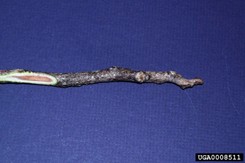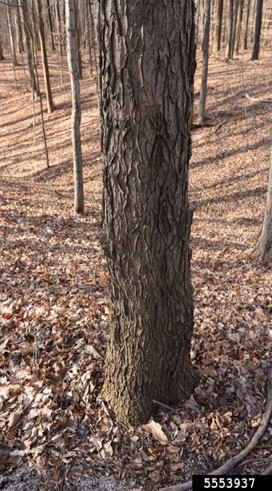AgEBB-MU CAFNR Extension
Green Horizons
Volume 22, Number 1
Winter 2018
Agroforestry
Species Spotlight: Kentucky Coffee Tree
By Hank Stelzer| MU Extension – School of Natural Resources
Kentucky coffeetree, Gymnocladus dioicus, occurs from Southern Ontario, Canada and in the United States from Kentucky (where it was first encountered by Europeans) and western Pennsylvania in the east, to Kansas, eastern Nebraska, and southeastern South Dakota in the west, to southern Wisconsin and Michigan in the north, and to northern Louisiana in the south.
 |
Gymnocladus dioicus leaves |
However, the tree is considered rare in the woods. This tree usually occurs as widely dispersed individuals or small colonial groups with interconnected root systems. This tree is found in floodplains and river valleys but is also sometimes seen on rocky hillsides and limestone woods. In some parts of its range, this tree may be used as an indicator of the presence of limestone or of calcareous soils. The tree is typically fairly short-lived, healthy trees living from 100 to 150 years.
 |
Gymnocladus dioicus twig |
General appearance. The tree varies from 60'-70' high with a spread of 40'-50', and a dbh up to 36". If it has no competing neighbors, coffeetree usually separates 10-15' from the ground into three or four divisions which spread slightly and form a narrow pyramidal head. When crowded by other trees, the tree can have a clear trunk for 50'-70'.
Leaves: Alternate, bi-pinnately compound, the largest of any native species, 1'-3' long, 18"-24" broad. Leaflets ovate, 2"-2 «" long, wedge-shaped or irregularly rounded at base, with wavy margin, acute apex. When full grown are dark yellow green above, pale green beneath. In autumn turn a bright clear yellow. The tree sheds its leaves early during the fall and appears bare for up to 6 months. The naked appearance of the tree is reflected through the species Latin genus name, which means "naked branch".
Flowers: Appear in June. Species is dioecious; male and female flowers on separate trees.
 |
Gymnocladus dioicus fruit (above) and bark (below) |
Fruit: Legume, 6"-10" long, 1«"-2" wide, somewhat curved, with thickened margins, dark reddish brown with slight glaucous bloom. Seeds six to nine, surrounded by a thick layer of dark, sweet pulp. Pods and seeds are considered poisonous and are reputed to contain the alkaloid cytisine.
Twigs: Stout, and blunt. Pith is large and salmon-pink in color. Winter buds are minute, depressed in downy cavities of the stem, two in the axil of each leaf.
Bark: Tan or dark gray, deeply fissured, surface scaly, often with prominent narrow ridges.
Wood: Light brown; heavy, strong, coarse-grained; durable in contact with the ground, takes a fine polish. Specific gravity, 0.6934; weight of cubic foot, 43.21 lb. The wood is used both by c cabinetmakers and carpenters. It has very little sapwood.
 |
Images courtesy of www.forestryimages.org. Paul Wray, Iowa State University, photographer. |
Food: The beans of the tree were eaten, after roasting, by the Meskwaki (Fox), Ho-Chunk (Winnebago) and Pawnee Native American cultures. The Meskwaki also drank the roasted ground seeds in a hot beverage similar to coffee. The common name "coffeetree" derives from this latter use of the roasted seeds, which was imitated by settlers because it seemed a substitute for coffee, especially in times of poverty, similar to chicory. Roasting is critical to break down the poisonous alkyloid, cytisine.
Good urban tree. Kentucky coffeetree is a moderately fast-growing tree, and male trees are often grown in parks and along city streets for ornamental purposes. The species is used as a street tree as far north as Montreal Quebec. It resists both harsh winters and de-icing salts.
Kentucky State Tree... for a while. From 1976 to 1994 the Kentucky coffeetree was the state tree of Kentucky, until the tulip-poplar was returned to that designation.
